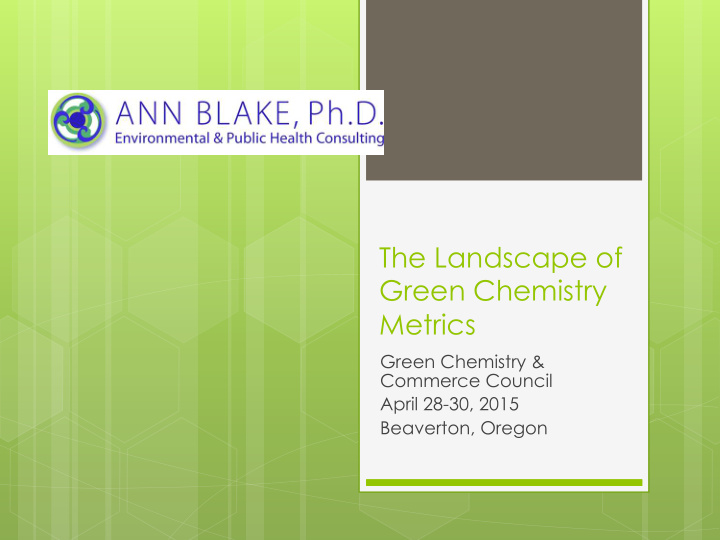



The Landscape of Green Chemistry Metrics Green Chemistry & Commerce Council April 28-30, 2015 Beaverton, Oregon
GC Metrics: Mapping The Landscape Goal: summarize and outline approaches to measuring progress towards green chemistry at several levels: Molecular/ Chemical Material, Product Firm, Sector Societal Define: What do we mean by “green chemistry” and what do we mean by “progress”?
GC3 Definition: Green Chemistry is a growing practice that reduces or eliminates the use or generation of hazardous substances in the design, manufacture, and application of chemical products. The application of Green Chemistry results in products and processes that protect and benefit the economy, people, and the planet and help us make significant strides toward a more sustainable future. Following the principles of green chemistry leads to the use of more sustainable feedstocks, development of less toxic products and processes, a reduction of energy and waste , and can lead to other manufacturing efficiencies
What we found…. Available metrics are all over the map, although options exist at each level Most measures are proxy measures : e.g., use/ release, concentration in biota, economic, health outcome, etc. Many tools are available for measuring movement away from Chemicals of Concern Fewer tools for moving towards preferable, chemicals/ materials/ products, but some moving that way, others with potential We have an opportunity to be more intentional about what we measure. And in the process define more clearly where we want to go
A Quick (Not Intended to be Comprehensive!) Tour Company level metrics, internally generated: Sigma Aldrich: example of process metrics Singlotex: translating Green Chemistry principles to products SC Johnson’s GreenList: chemical ingredient level tracking, rolled up to product and firm Externally derived tools & benchmarks Material, product level Societal Level Human health and environment
Translating GC Principles to Products
SC Johnson’s Greenlist “The goal was to go beyond taking out “bad” ingredients and instead focus on choosing “better” options and continuously improving formulas based on information about ingredients’ impact on the environment and human health.”
Ingredient/ Material/ Product Not metrics per se, but tools that could be utilized to track progress to greener chemistry: Material in Product: Cradle to Cradle Material Health Assessment: “Knowing the chemical ingredients of every material in a product, and optimizing towards safer materials” Comparing Materials: Green Blue’s Material IQ : “…designed to facilitate more effective communication of chemical and material level data between all stakeholders in a product value chain.” Comparative Hazard in a Material Class BizNGO/ Clean Production Action’s Plastics Scorecard Hazard based assessment of polymer process chemistry Next phase: hazard assessment of functional additives
Externally Derived Firm Level Metrics Michigan Business Green Chemistry Checklist Education Internal training opportunities for staff, awards, etc. Hiring Explicit reference to green chemistry in job postings Include GC in performance requirements Design and Innovation New green chemistry products and processes Progress towards green chemistry goals Support and Communication Collaboration with local academic institutions Communicate GC goals to suppliers Chemical management at firm level: Chemical Footprint Project (CPA, Lowell, Pure Strategies): “tool for benchmarking companies as they select safer alternatives and reduce their use of chemicals of high concern”.
Societal Metrics, examples Monitoring of humans and other biota PBDEs in Swedish breast milk, San Francisco Bay shellfish Nordic SPIN: Substances in Products in Nordic Countries Washington Children’s Safe Products Act US EPA’s Toxics Release Inventory Reduction in use of specific chemicals or class of chemicals Reduction of use of reportable chemicals by a company or facility Reduction of use of certain chemistries by sector E.g., pharmaceuticals (possibly from process efficiency, not changes to more benign chemistries)
If the Vision is…. Products and processes that protect and benefit the economy, people and the planet then: Metrics should move us towards these goals Existing work and metrics fit into this: Ingredient disclosure and supply chain transparency lets to better characterized chemistry, which leads to opportunities for improvement….
This is an opportunity: What could a “better “ measure look like? Different metrics at different parts of the supply chain: Molecular/ Process: adherence to 12 principles Firm/ Sector: number/volume of products containing greener chemistries Societal: lifting of specific disease burden, environmental contamination Some Other Ideas: Potential Health metrics: Reduction of cancer and other diseases for most impacted populations Challenge: tying individual chemicals to specific diseases; tracking regrettable substitutions Economic metrics: jobs, R&D spending, patents, investment (in products, education, etc.) Connect with parallel health and economics-focused efforts Cancer-Free Economy, First 1000 Days
Moving Forward: For Safer Materials: US EPA Presidential Green Chemistry Award Criteria Reduce toxicity (acute or chronic) or the potential for illness or injury to humans, animals, or plants Reduce flammability or explosion potential Reduce the use or generation of hazardous substances, or their releases to air, water, or land Improve the use of natural resources, for example, by substituting a renewable feedstock for a petroleum feedstock Save water or energy Reduce the generation of waste, even if the waste is not hazardous
Moving forward: Other potentially useful starting points: Emerging sector chemical disclosure/ tracking efforts (if transitioned from tracking “bads” to moving to better chemistries) Apparel/ footwear: ZDHC Data Schema work stream: in data-gathering phase Built Environment: Health Product Declaration Natural Products Association Lists of banned AND preferred ingredients and processes >1,100 products currently meet these standards
For Discussion Where do you think we need to develop better metrics? What key indicators would GC3 need to track for “progress in Green Chemistry”?
( 510) 768-7008 ann@annblake.com www.annblake.com
Recommend
More recommend